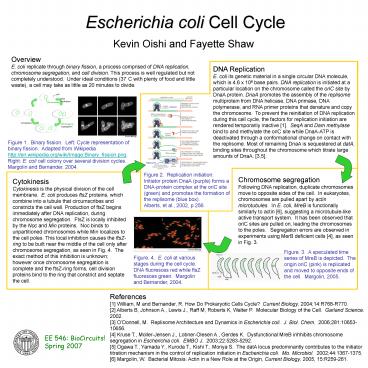Cytokinesis PowerPoint PPT Presentation
1 / 1
Title: Cytokinesis
1
Escherichia coli Cell Cycle
Kevin Oishi and Fayette Shaw
Overview E. coli replicate through binary
fission, a process comprised of DNA replication,
chromosome segregation, and cell division. This
process is well regulated but not completely
understood. Under ideal conditions (37C with
plenty of food and little waste), a cell may take
as little as 20 minutes to divide.
DNA Replication E. coli its genetic material in a
single circular DNA molecule, which is 4.6 x 106
base pairs. DNA replication is initiated at a
particular location on the chromosome called the
oriC site by DnaA protein. DnaA promotes the
assembly of the replisome multiprotein from DNA
helicase, DNA primase, DNA polymerase, and RNA
primer proteins that denature and copy the
chromosome. To prevent the reinitiation of DNA
replication during this cell cycle, the factors
for replication initiation are rendered
temporarily inactive 1. SeqA and Dam methylase
bind to and methylate the oriC site while
DnaA-ATP is deactivated through a conformational
change on contact with the replisome. Most of
remaining DnaA is sequestered at datA, binding
sites throughout the chromosome which titrate
large amounts of DnaA. 3,5.
(DnaA)
Figure 1. Binary fission. Left Cycle
representation of binary fission. Adapted from
Wikipedia http//en.wikipedia.org/wiki/ImageBinar
y_fission.png. Right E. coli cell colony over
several division cycles. Margolin and Bernander,
2004.
replisome
Chromosome segregation Following DNA replication,
duplicate chromosomes move to opposite sides of
the cell. In eukaryotes, chromosomes are pulled
apart by actin microtubules. In E. coli, MreB is
functionally similarly to actin 6, suggesting a
microtubule-like active transport system. It has
been observed that oriC sites are pulled on,
leading the chromosomes to the poles.
Segregation errors are observed in experiments
using MerB deficient cells 4, as seen in Fig. 3.
Figure 2. Replication initiation Initiator
protein DnaA (purple) forms a DNA-protein complex
at the oriC site (green) and promotes the
formation of the replisome (blue box). Alberts,
et al., 2002, p 256.
Cytokinesis Cytokinesis is the physical division
of the cell membrane. E. coli produces ftsZ
proteins, which combine into a tubule that
circumscribes and constricts the cell wall.
Production of ftsZ begins immediately after DNA
replication, during chromosome segregation. FtsZ
is locally inhibited by the Noc and Min proteins.
Noc binds to unpartitioned chromosomes while Min
localizes to the cell poles. This local
inhibition causes the ftsZ-ring to be built near
the middle of the cell only after chromosome
segregation, as seen in Fig. 4. The exact method
of this inhibition is unknown however once
chromosome segregation is complete and the
ftsZ-ring forms, cell division proteins bind to
the ring that constrict and septate the cell.
Figure. 3. A speculated time series of MreB is
depicted. The origin oriC (pink) is replicated
and moved to opposite ends of the cell.
Margolin, 2005.
Figure. 4. E. coli at various stages during the
cell cycle. DNA fluoresces red while ftsZ
fluoresces green. Margolin and Bernander, 2004.
References 1 William, M and Bernander, R. How
Do Prokaryotic Cells Cycle? Current Biology,
200414R768-R770. 2 Alberts B, Johnson A.,
Lewis J., Raff M, Roberts K, Walter P. Molecular
Biology of the Cell. Garland Science. 2002. 3
ODonnell, M. Replisome Architecture and
Dynamics in Escherichia coli. J. Biol. Chem.
200628110653-10656. 4 Kruse T., Moller-Jensen
J., Lobner-Olesen A., Gerdes K. Dysfunctional
MreB inhhibits chromosome segregation in
Escherichia coli. EMBO J. 2003225283-5292. 5
Ogawa T., Yamada Y., Kuroda T., Kishi T., Moriya
S. The datA locus predominantly contributes to
the initiator titration mechanism in the control
of replication initiation in Escherichia coli.
Mo. Microbiol. 2002441367-1375. 6 Margolin,
W. Bacterial Mitosis Actin in a New Role at the
Origin, Current Biology, 2005, 15R259-261.
EE 546 BioCircuits! Spring 2007

